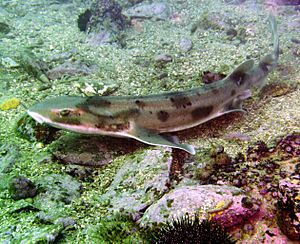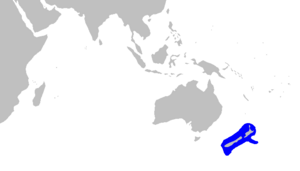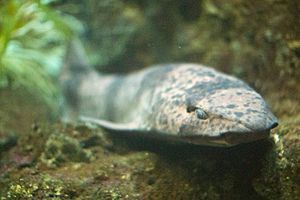Draughtsboard shark facts for kids
Quick facts for kids Draughtsboard shark |
|
|---|---|
 |
|
| Conservation status | |
| Scientific classification | |
| Genus: |
Cephaloscyllium
|
| Species: |
isabellum
|
 |
|
| Range of the draughtsboard shark | |
| Synonyms | |
|
|
The draughtsboard shark (Cephaloscyllium isabellum) is a type of catshark. It gets its name from its "checkerboard" pattern of dark spots. This shark lives only in New Zealand. People there sometimes call it the carpet shark.
This shark usually grows to about 1 meter (3 feet) long. It has a thick body and a wide, flat head with a big mouth. Its two dorsal fins are located far back on its body. The first dorsal fin is much bigger than the second one.
Draughtsboard sharks can live very deep, sometimes as far down as 673 meters (2,200 feet). During the day, they like to stay near rocky reefs. At night, they move to sandy areas to find food. They eat fish and other small sea creatures. When a predator threatens them, they can take in water or air to make their bodies bigger. This might be why they sometimes make a sound like a dog's bark! Female draughtsboard sharks lay smooth, egg cases with long, curly parts. These sharks are often caught by accident by fishing boats. However, they are usually strong enough to survive and be released back into the ocean. The International Union for the Conservation of Nature (IUCN) says this shark is of "Least Concern", meaning it's not currently endangered.
Contents
About the Draughtsboard Shark's Name
The draughtsboard shark was first described by a French naturalist named Pierre Joseph Bonnaterre. He wrote about it in 1788 and gave it the name Squalus isabella. Later, scientists moved this shark to the group called Cephaloscyllium.
This shark looks a lot like the blotchy swellshark and the Australian swellshark. For a while, some people thought they might all be the same species. However, the draughtsboard shark has different colors and its egg capsules are smooth, unlike the ridged ones of the Australian swellshark. It also has different body shapes and colors compared to the blotchy swellshark.
Where Draughtsboard Sharks Live
The draughtsboard shark is found only in the waters around New Zealand. This includes places like the Snares, the Chatham Islands, and Stewart Island. They are especially common around Stewart Island.
These sharks usually live in waters from 0 to 400 meters (0 to 1,300 feet) deep. But they have been seen as deep as 673 meters (2,200 feet). They are bottom-dwellers, meaning they stay close to the seabed. They prefer rocky reefs and nearby sandy areas. Adult male and female sharks tend to live in separate areas.
What Draughtsboard Sharks Look Like
Most draughtsboard sharks are about 1 meter (3 feet) long. However, some can grow up to 1.5 meters (5 feet). There was a report of one being 2.4 meters (8 feet), but this was probably a different type of shark. Female sharks usually grow larger than males.
This shark has a strong, torpedo-shaped body that gets thinner towards its tail. Its head is short, wide, and a bit flat, with a rounded snout. It has small flaps of skin in front of its nostrils. Its oval eyes are somewhat on top of its head and have thick ridges around them. Behind the eyes are small holes called spiracles. The mouth is very large and curved.
The pectoral fins are quite big and wide. The two dorsal fins are placed far back on the body. The first dorsal fin starts above the middle of the pelvic fins. The second dorsal fin starts above the anal fin. The second dorsal fin is much smaller than the first, and also smaller than the anal fin. Male sharks have short, thick claspers. The caudal fin (tail fin) is short and wide.
The shark's skin is thick and covered in small, hard scales called dermal denticles. The draughtsboard shark's color gives it its name. It is golden to brown on top and lighter underneath. It has up to 11 dark brown, uneven "saddles" (stripes) on its back. These stripes switch with blotches on its sides, creating a checkerboard pattern. There's also a special saddle mark between its spiracles that stretches back over its gill slits.
Draughtsboard Shark Habits and Diet
During the day, the draughtsboard shark is quite slow. It usually hides inside cracks or caves in the reef. At night, it comes out to search for food over sandy areas nearby.
This shark eats many different kinds of fish and small sea creatures. Its diet includes spiny dogfish, cod, sand perch, blennies, octopus, squid, snails, innkeeper worms, krill, hermit crabs, crabs, spiny lobsters, and even sea squirts. People have seen these sharks sucking innkeeper worms out of their burrows. They have also been seen swimming around for hours with the antennae of large lobsters sticking out of their mouths! A type of tapeworm called Calyptrobothrium chalarosomum can be a parasite of this shark.
Like other Cephaloscyllium sharks, the draughtsboard shark can inflate its body a lot when a predator is near. This defense might be why some people say it barks like a big dog. It usually inflates with water. But if it's caught by humans and brought to the surface, it might inflate with air instead. When the shark lets the air out, the "bark" sound comes from the air rushing out of its stomach.
Draughtsboard sharks lay eggs. Females lay two eggs at a time. The egg cases are smooth and cream-colored, about 12 cm (5 inches) long. They have long, spiral tendrils at the corners. These tendrils help the egg cases attach to things underwater. When the baby sharks hatch, they are about 16 cm (6 inches) long. Males become adults when they are about 60 cm (2 feet) long, and females when they are about 80 cm (2.6 feet) long.
Draughtsboard Sharks and People

Draughtsboard sharks are common and not harmful to humans. They are often caught by accident in fishing nets, especially by boats fishing for rock lobster. It is likely that most of these sharks survive and are returned to the water alive. This is because they can stay out of water for a long time.
From 1988 to 1991, there was a shark liver fishery in New Zealand. During this time, between 74 and 540 tons of draughtsboard sharks were caught each year. After this fishery stopped, the number of sharks caught dropped to less than five tons per year.
How Draughtsboard Sharks Are Protected
The New Zealand Department of Conservation has said that the draughtsboard shark is "Not Threatened." This means its population seems healthy and it doesn't face any major dangers. Because of this, the International Union for the Conservation of Nature (IUCN) has listed this species as of "Least Concern".
Images for kids
See also
 In Spanish: Cephaloscyllium isabellum para niños
In Spanish: Cephaloscyllium isabellum para niños




